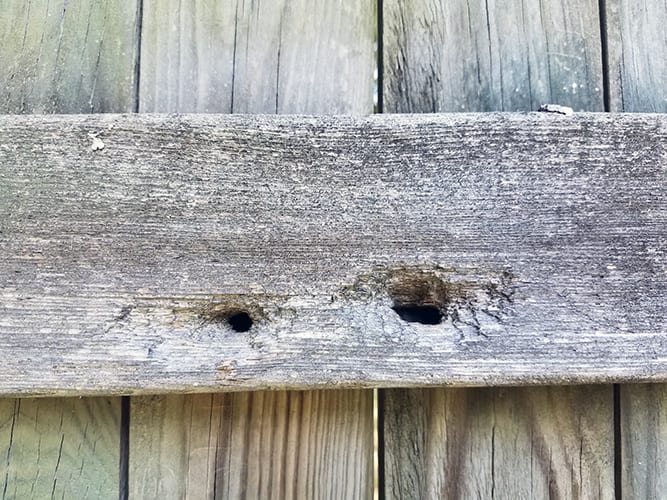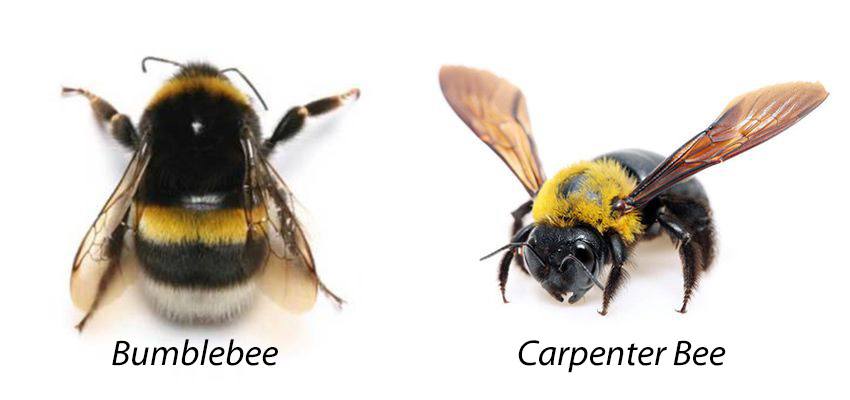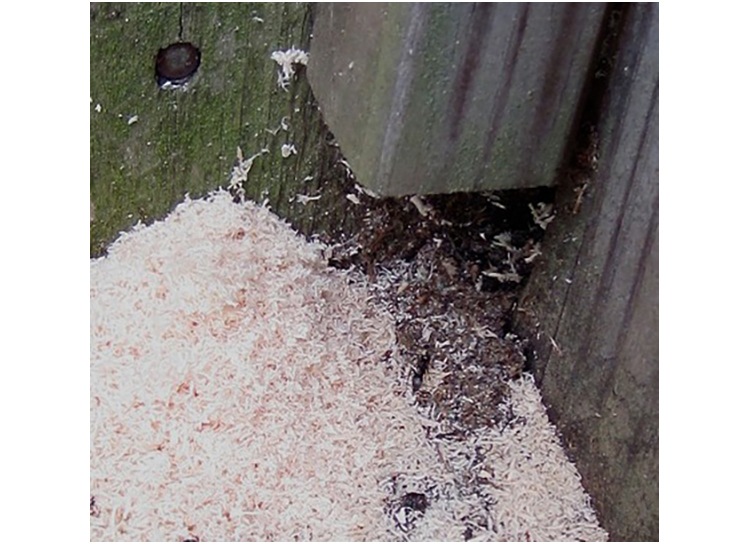
How To Get Rid Of Carpenter Bees
If you currently have a carpenter bee infestation, the time to treat is today. Follow these guidelines to Get Rid of Carpenter Bees safely.
Carpenter bees are a beneficial insect but they are also destructive to wooden structures. Female Carpenter Bees drill holes into any wooden structure they can find in order to lay their eggs. This article details the best ways to identify carpenter bees, prevent infestations, and stop them from doing further damage to your home.
How To Get Rid Of Carpenter Bees (3 Steps)
1. Spray A Residual Insecticide to Kill Carpenter Bees
A great way to get rid of carpenter bees is to spray residual insecticides. The best times to apply are early spring before the infestation starts or during the active infestation. You will want to spray the areas where carpenter bees are boring into wood with residual insecticides such as Cyzmic CS, Demon WP and FenvaStarCap.
Their holes are usually located on the underside of wood surfaces, We recommend spraying twice during the spring months at intervals of 3-4 weeks to most efficiently prevent carpenter bee damage.
When protected from the elements like rain, residual insecticides will last 2 to 3 months. If you apply in these areas in later winter, you could see residual effects that last through the carpenter bee season.
Severe Infestations
You may need to repeat carpenter bee treatments more than twice during the spring. We suggest an interval of two weeks for spray treatments. After each spray treatment, apply D-Fense Dust or Tempo Dust to all possible carpenter bee nests, holes or entry points.
2. Use Dust In Carpenter Bee Nests
Using insecticidal dusts such as Tempo Dust, D-Fense Dust and Delta Dust are grate way to help eliminate your active carpenter bee infestation. You will want to apply this dust in every carpenter bee hole that you find. We recommend using a duster such as the JT Eaton Hand Bellow Duster.
To get rid of an active Carpenter Bee infestation, apply Tempo Dust in every carpenter bee hole that you find. Use a recommended duster such as the JT Eaton Hand Bellow Duster
Although the initial damage to wood appears as a small hole, only an inch or two deep, it usually extends at a 90-degree angle. The female will turn 90 degrees and bore a channel from 6 inches to as long as 4 feet. This channel serves as the main corridor from which she will drill small chambers. These chambers serve as egg nests. She deposits eggs. Brings in food, and then seals off the area to ensure the egg's development.
- To learn more about carpenter bee holes: Carpenter Bee Holes

3. Plug Carpenter Bee Holes
- Plug the holes after all the bees are killed. A safe time to plug entrances is in the early fall months.
- You can plug the entrances with plugs, cork, putty, or a caulking compound. We suggest sealing the holes with wood putty since you can paint over the wood after the bees are removed. We also carry Carpenter Bee Blocker Kits that are made of stainless steel screens with installation tools.
- If you plug up the entrances too early, they may chew new openings in other locations.
- Spray carpenter bee nests early in the season (Jan, Feb, etc) to prevent further boring. You can prevent carpenter bee infestations if you tackle the situation early

(Optional Step)- A Non-Chemical Natural Approach
For those considering a non-chemical approach during an active carpenter bee infestation, we recommend using carpenter bee traps and natural repellents.
Carpenter bee traps are designed to attract and trap the bees. If you have an existing infestation, hang the trap directly over the carpenter bee holes. If you do not have a current infestation, hang the traps at the peaks and corners of your home, preferably on the sunniest side of your house.
Carpenter bees do not like the citrus scent. You can either make your own repellent using citrus fruits and boiling them or we have a citrus carpenter bee repellent we recommend. Other essential oils such as lemon, almond, and peppermint.
How To Identify A Carpenter Bee
Carpenter Bees look similar to Bumble Bees - large, with yellow and black patterns.
They are about 1/2 to 1 inch and may have some metallic reflections ranging from dark blue, yellow, green, or purple tints. Their abdomens are bare and shiny, compared to the Bumble Bee. Bumble Bees are not a wood boring insect. You’re more likely to find them sitting on flowers in the yard. They are highly beneficial and we suggest leaving them to tend to pollination.
Carpenter Bees are commonly found in the spring. They hover around eaves, porch rails, and under decks and any other unpainted wood around your home. Sometimes carpenter bees are called "wood bees" because they bore into wood.
For More Information:
Difference Between Carpenter Bees and Bumble Bees

For More Information:
Carpenter Bee Signs/Identification
Do Carpenter Bee’s Sting?
Yes and no!
The female carpenter bee does have a stinger and is capable of stinging, but she rarely does unless she is really provoked. The male on the other hand does not have a stinger but will be more aggressive. Female’s will have a solid black head while the male’s will have a yellow splotch right in the center of their head.
To avoid being stung its best to avoid provoking carpenter bees all together because it can be difficult to identify male and females while they are flying around. Try to avoid picking the carpenter bees up and be careful if you are sticking something like a duster into a hole that they currently occupy.
At the end of the day, carpenter bees pose little threat to stinging you but it's always smart to be cautious when they are around. And the best way to prevent getting stung is by getting rid of you carpenter bees altogether.
Signs of Carpenter Bee Infestations
Carpenter Bees make holes about 1/2 inch in diameter. They prefer unfinished wood, but are capable of drilling and creating tunnels in seasoned hardwoods, softwoods, and decaying woods. Frass is the result of already damaged wood. It looks like sawdust around the drilling areas.
Female carpenter bees bore channels (also known as a main corridor in wood). The damaged area will be 6" to as long as 4 feet wide. The female lays her eggs in areas called "galleries" or "cells". She deposits eggs into these galleries and brings feeds them with a mass of pollen for the newly larvae to feed. She then seals them off to ensure their development before she repeats the next egg process. This is one of the reasons it can be so hard to get rid of carpenter bees.
Successfully preventing carpenter bees is determined by the time of year. You can prevent carpenter bee infestations if you tackle the situation early in the season.
- Finish wood: Carpenter Bees attack unfinished wood under decks, sills, and decks first. Varnish or paint these wood surfaces to make them less attractive to these bees. A fresh coat of paint is unattractive to a Carpenter Bee.
- Seal openings: Seal as many exterior openings as possible before spring. These openings could include Carpenter Bee holes from the previous season. For the existing Carpenter Bee holes, we recommend Carpenter Bee Blocker Kits that have stainless steel screens that fit in carpenter bee holes. These screens allow you to still be able to spray dusts inside which is important the eggs are still inside the hole.
- Spray Insecticides: Spray the unfinished wood in these vulnerable areas (under rail sidings, under decks, around windowsills, etc.) with the recommended residual insecticides in either early spring or during active infestations (springtime).
- Dust: Use insecticidal dust in the fall and early spring to eliminate any existing carpenter bees or their eggs.
- Carpenter bee traps: Hang Carpenter Bee Traps in areas where you have seen the most activity in previous years. Keep in mind that carpenter bees like sun so areas that receive the most sun are recommended. Carpenter bees are attracted to other carpenter bees so it may be necessary to apply a bait such as Bee-Luscious Bee Bait to the carpenter bee trap.
- Natural repellents: Apply natural repellents in the early spring where you have seen past infestations or under decks and sills.
- Play Music: Carpenter bees do not like loud music or sounds. If putting speakers outside near your infestation does not sound appealing, wind chimes could be used as a good alternative.
- Swing Away! As barbaric as it might sound, having any stringed racquet handy is a great way eliminate carpenter bees that may be flying around.
Pro Tip: If you have carpenter bee traps, place dead carpenter bees in the trap and it will make them more affective.

Residual Insecticides (For Active Infestations Or Prevention)
Residual Insecticide Sprays
- Cyzmic CS, FenvaStar EcoCap, and Avesta CS - Will not leave a visible residue.
- Cyper WSP or Demon WP - Will leave a visible residue seen against dark surfaces
Residual Insecticide Dusts
- Tempo Dust, D-Fense Dust, and Delta Dust
- Carpenter Bee Kits - Save Money - Combine the residual insecticides, with a dust and a duster for application.
Carpenter Bee Kits
Natural Solutions
Carpenter Bee Kits (Combines residual insecticides and Dusts)
- Save 10% on Carpenter Bee Kits, use code: carp22
How To Discourage Woodpeckers
Key Takeaway
Woodpeckers may peck into carpenter bee tunnels in the wood trying to eat the bee larvae. Spray a residual insecticide into the carpenter bee holes and on the wood in the spring. This will discourage the carpenter bees from attacking the wood. This, in turn, will discourage woodpeckers.
Quick Tips for Year-Round Carpenter Bee Prevention
Key Takeaway
Prevent holes by spraying insecticide concentrates. Treat existing holes with insecticide dusts.
Recommended Carpenter Bee Control Products
Written by our resident pest control expert Ken Martin.




